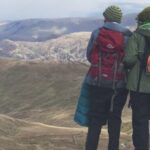The Grand Canyon is a natural wonder of the world, attracting millions of visitors every year for hiking, camping, and backpacking trips. Choosing the right time to explore this breathtaking beauty is critical for a safe and successful trip. Temperature, precipitation, trail conditions, and daylight hours are just a few of the factors that must be considered. This section will provide an introduction to the best time to visit the Grand Canyon, with information on each season and its advantages and disadvantages.
Whether you’re a seasoned hiker or a novice adventurer, understanding the timing of your Grand Canyon visit is key to a memorable and enjoyable experience. So, let’s dive in and explore the different times of the year when you can admire this magnificent natural wonder. Mid-October is a great time to visit for those looking to see fall colors and avoid the summer crowds. Ancient rocks dating back millions of years, sculpted by the Colorado River, tower over the canyon’s colors.
Helicopter tours offer an incredible view of this mesmerizing landscape, even though it comes with slightly lower prices. Bright Angel Trail, a popular hiking route, can be more challenging during these seasons, but the crisp air and colorful scenery make it entirely worth the effort.
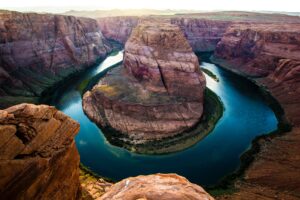
Best seasons to hike Grand Canyon
The best seasons to hike Grand Canyon depend on individual preferences and priorities, including the desire to save money. Summer, despite being the busiest time of the year, is still a popular choice for hikers as the trails are open year round. However, the temperatures can reach up to 100°F in the inner canyon during this season, making it dangerous for inexperienced hikers or those not accustomed to the heat.
Early spring and mid-October, around the same time as the scenic Las Vegas party scene, are optimal seasons to hike Grand Canyon as there are milder temperatures and smaller crowds. A day hike during mid-October can be a perfect trip with guided hiking tours available to help explore the terrain. However, early spring can bring unpredictable weather, including snow, rain, and wind which can cause trail closures.
On the other hand, the winter months, such as early November, provide a unique experience to see the canyon covered in white snow and ice, but hiking during this season can be challenging due to colder weather, icy trails, and limited facilities and services. Winter also has the advantage of fewer crowds, allowing hikers to enjoy a more peaceful and quiet experience, but caution should be taken as the altitude above sea level can make hiking more difficult for some.
Ultimately, choosing the best season to hike Grand Canyon depends on individual experience, skill level, and comfort level with weather and crowds. It is important to plan ahead, check weather conditions, and have proper gear and training to ensure a safe and enjoyable hiking experience.
Consideration of weather and temperature
When planning a visit to Grand Canyon National Park, one of the most important considerations is the park’s weather and temperature. As the Grand Canyon’s located in a desert environment, extreme temperatures can range from scorching hot weather during the day to freezing cold temperatures at night. Therefore, it’s essential to plan your visit according to the season and time of day, as well as checking the daily forecast before starting your trek.
If you are planning a hike on the South Rim, during the summer months, it is advisable to start early in the morning to avoid the hottest part of the day, typically between 11 am and 4 pm, to avoid the hot weather. However, the North Rim provides colder temperatures and can be a great option during the summer months.
Conversely, mid-October and the winter seasons can provide more comfortable hiking conditions with lower temperatures, including the option for backcountry camping, but there’s also the potential for snow and ice on the trails, so hikers must come prepared with appropriate equipment to stay safe.
Additionally, if you are planning to visit Grand Canyon National Park anytime, it’s crucial to properly hydrate during your hike, especially in the hot weather during the summer months, as dehydration can lead to heat exhaustion or even heat stroke. Regardless of when you choose to visit the Grand Canyon, keeping weather and temperature in mind will undoubtedly ensure a safe and enjoyable experience.
Time of day for optimal experience
The Grand Canyon is a phenomenal landscape that offers awe-inspiring views and epic hikes. Although the best time to hike Grand Canyon may depend on individual preferences, weather patterns, and other factors, the time of day you hike can have a significant impact on your experience.
Mornings in mid-October, with their cooler temperatures, fewer crowds, and golden hour light, are the best time to start your hike. You can also witness an amazing sunrise that sets the canyon aglow with a riot of colors, creating a truly unforgettable experience. During monsoon season, it is best to avoid hiking during midday because of the high temperatures that can be hot and exhausting.
Instead, it is better to rest and take a break or explore the canyon’s many viewpoints while wearing warm clothes. Afternoon and evening hikes in the busiest season offer an entirely different perspective and the unique colors and shadows transform the canyon. Also, if you’re lucky, you might catch a glimpse of the vibrant sunset over the canyon’s rim.
No matter what your preference is, whether it be mid-October, monsoon season, or the busiest season, the best time of day to hike Grand Canyon is subjective. Just be sure to plan based on the weather forecast and the season, wear proper hiking gear, and bring plenty of water to stay hydrated throughout your trek.
Exploring trails and difficulty levels
The Grand Canyon, located in Northern Arizona, offers over 800 miles of hiking trails that vary in difficulty levels, making it crucial to evaluate your skill level and physical fitness while choosing the appropriate trail. For those who have the Grand Canyon on their bucket list and are new to hiking, the South Kaibab Trail, offering well-maintained trails and breathtaking panoramic views, is an excellent option.
In mid-October, avoiding big crowds, explore the Hermit Trail, with its rocky terrain and unique views of the canyon’s geology, and camp at the Bright Angel Campground if staying overnight.
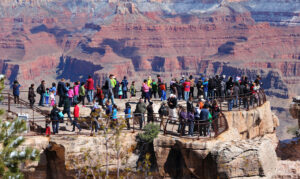
Advanced hikers, confident in their ability, may take on the challenge of the West Rim, providing views from Hopi Point and Mather Point, or the North Kaibab Trail, undertaking the gruelling 16-mile trek to the Colorado River, providing stunning views of the canyon’s inner gorge.
Before embarking on your Grand Canyon hiking adventure, always check the trail conditions and pack essential items like sunscreen, snacks, and plenty of water, remembering that timing is everything, and you shall be mindful of your physical limitations while enjoying the natural wonder.
Planning ahead for permits and logistics
Planning ahead is crucial for anyone who wants to go hiking in the Grand Canyon. One important aspect of such planning is getting the necessary permits. Depending on the type of adventure and the location of the desired trailhead, a permit might be required to hike down to the canyon floor.
For example, visitors who plan to stay overnight in the canyon, whether at a backcountry campsite or the popular Phantom Ranch, must secure a permit in advance.
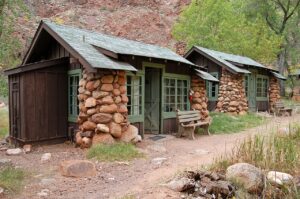
Similarly, visitors who intend to go in mid-October must be part of a lottery system, as there are many restrictions in place to protect the delicate ecosystem of the Grand Canyon and to avoid crowds. In addition, visitors must determine the best time to visit the Grand Canyon, as it varies depending on the time of year and individual preferences.
Some people prefer hiking the Grand Canyon in great weather when it’s cooler and with less crowded conditions and choose to go in the winter. While others prefer the busier summer months to share the experience with more people. In terms of logistics, visitors must also consider transportation to and from the trailhead, as well as their physical abilities and level of experience.
By planning ahead for hiking grand canyon, visitors can ensure a successful and enjoyable experience in one of the most awe-inspiring natural wonders in the world.
Accommodations and amenities available
There are plenty of accommodation options available for visitors at the Grand Canyon, both inside and outside the park. Within the park, visitors can choose from a range of lodges and campgrounds catering to different budgets and preferences.
The Bright Angel Lodge and Phantom Ranch inside the park are popular choices, offering rustic cabins and rooms with basic amenities along with restaurants and gift shops. For those looking for a more luxurious experience, the El Tovar Hotel, located just steps from the rim, offers spacious rooms with modern amenities, fine dining, and a cozy lounge with a fireplace.
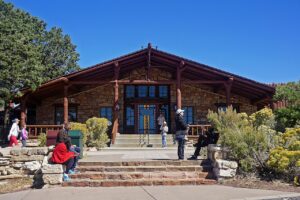
Outside the park, travellers can find motels, hotels, and vacation rentals in the nearby town of Tusayan or in nearby cities like Flagstaff and Williams. Visitors can also take advantage of amenities available at the trailheads, such as restrooms, water stations, and picnic areas.
Whatever your accommodation preference, it’s important to book early, especially during peak season, as availability can be limited. Be sure to also pack appropriately for your trip, bringing food, water, and any necessary gear to ensure a safe and enjoyable experience in the park.
Environmental conservation and responsibility
Environmental conservation and responsibility are vital components of any real adventure, especially for most visitors of national parks like the Grand Canyon. The practice of minimizing our impact on the environment and wildlife populations is critical to maintaining the integrity of the natural system when avoiding crowds during peak season. It’s essential to practice the seven Leave No Trace principles and respect the natural habitat of the canyon’s unique wildlife when many hikers venture on the trails.
We all have a responsibility to ensure that the majestic beauty of the Grand Canyon is preserved for generations to come, even during mid-October when inner gorge temperatures can drop, and it’s pretty hot. Hikers should be mindful of their waste, as humans produce an enormous amount of waste daily, and improperly disposed of trash can harm the delicate ecosystem. Hence, hikers should carry out all materials, including food waste, avoiding polluting the trail and waterways.
Furthermore, sticking to marked trails near Desert View Watchtower and creating rock shelters that serve as their bathroom facilities can cause soil erosion and damage to the surrounding vegetation, affecting the entire biological balance of the park during hiking season. Careful preparation and planning are crucial to reducing our impact on the environment in the Grand Canyon.
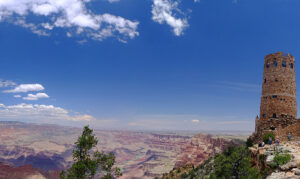
With the right approach, hikers can enjoy a memorable and meaningful experience while minimizing their environmental footprint, and responsible behavior while enjoying the Grand Canyon is a gesture of respect for the environment and all the wildlife that calls the park home.
Conclusion
In conclusion, finding the best time to explore Grand Canyon ultimately depends on your own preferences and priorities. If you’re seeking the best weather conditions and want to avoid the summer crowds, the shoulder seasons of late spring and early fall could be ideal for you.
On the other hand, if you’re looking for warmer weather and want to enjoy the full range of activities available in the park, summer may be the best time for you. And if you’re willing to brave the cold and want to witness the stark beauty of the canyon covered in snow, winter could be the perfect time to plan your visit.
No matter what time of year you choose to explore Grand Canyon, it’s important to be well-prepared with appropriate clothing, gear, and knowledge of the terrain and weather conditions. With proper planning and a willingness to adapt to the challenges the canyon may throw your way, you’re sure to have a memorable and rewarding experience in one of the world’s most awe-inspiring natural wonders.


